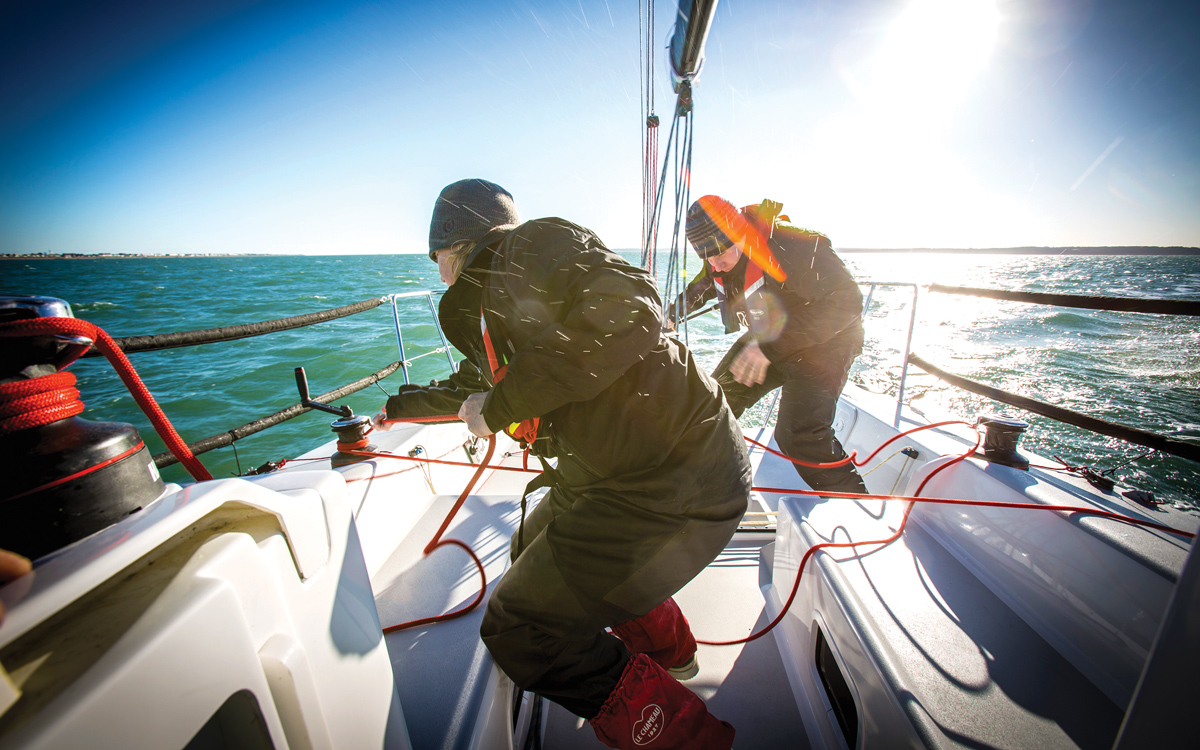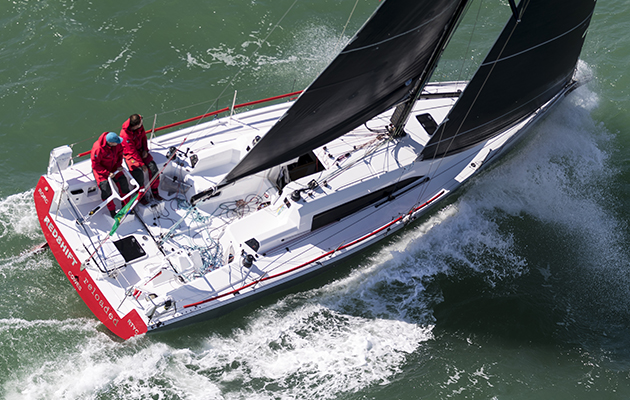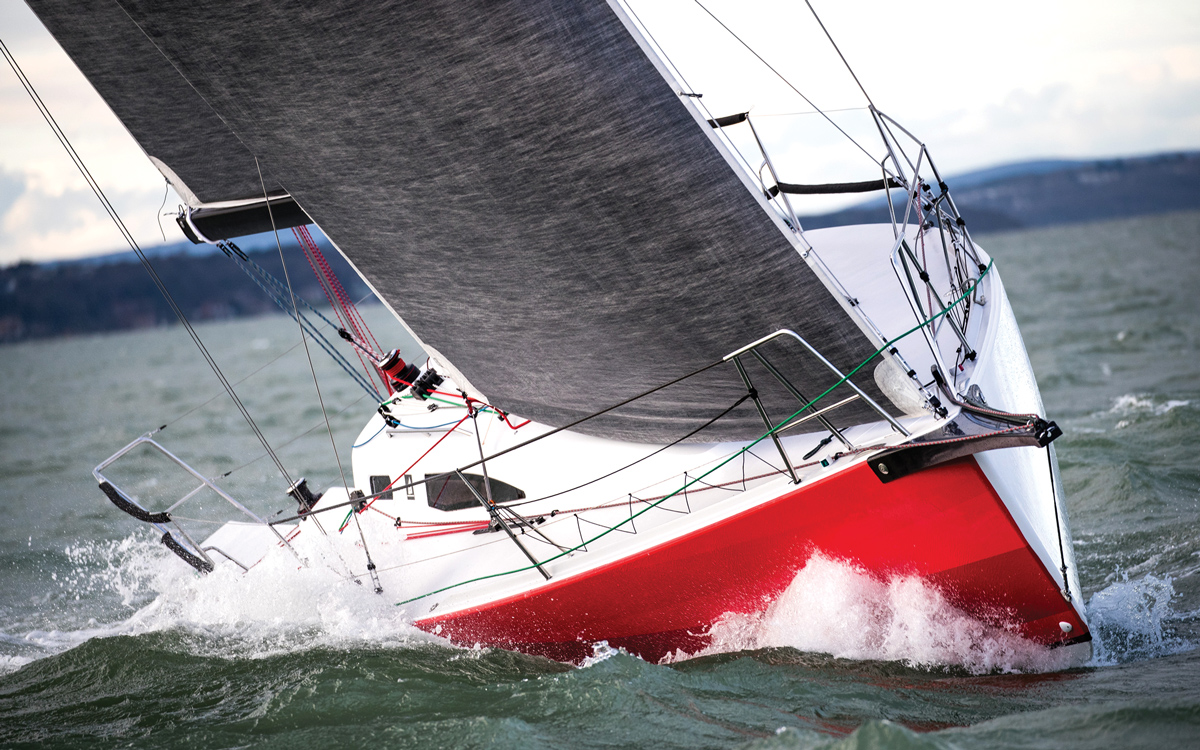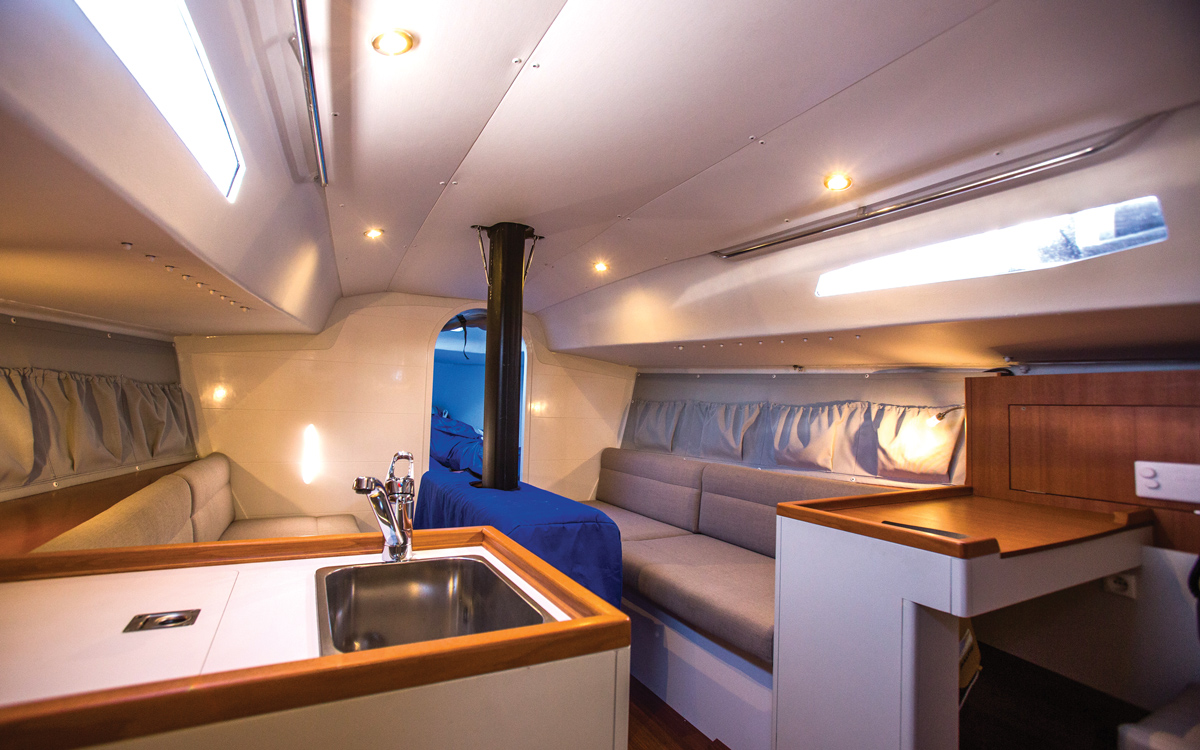The new J/99 is a versatile 32ft offshore speedster that targets the double-handed racing circuit
We ghosted down the Hamble River under mainsail alone, the water slipping silently past our red hull in the grainy half-light of a winter morning. We’d hoisted the mainsail in our marina berth, then sailed out into the river, the engine left in tick-over for less than two minutes almost as a token gesture. I felt like a naughty kid, slipping out while the rest of the world was still waking up; going to make some trouble.
I had come to test the new J/99, sailing double-handed with the British J/Boats importer Paul Heys on a chilly, blustery January morning. Within ten minutes our demure departure was all but forgotten as we came bursting out of Southampton Water, our senses assaulted from all angles by the bitter north wind and our 100m2 day-glo spinnaker. As the sun rose, everything about the day and this little powerhouse of a boat became bright, sharp and dynamic. I don’t know what the rest of the world was doing at 0800 on that January morning but we were having a blast.
The eagerly awaited J/99 directly targets a growing demographic of sailors who enjoy the fantastic short-handed racing scene available all across Europe. Of the 38 orders already confirmed, over half of the new owners intend to race short-handed and it was with this type of sailing in mind I arrived to make the test.

There’s plenty of room for the helmsman to pass across the aft section of the boat during a tack, leaving the whole cockpit free for the crew
The new design incorporates some interesting changes for J/Boats, which bring the J/99 into line with its closest rivals in this area of the market. Gone is the retractable bowsprit and furling jib, which have been the stalwarts of J/Boat design for close to 20 years, making way for a beamier shape, a fixed bowsprit and a hank-on jib. It’s different, but despite the new features, this still remains resolutely ‘J’ in its appearance and feel.
From the first moment I stepped into the cockpit, this boat struck me with its no-nonsense approach. Sail handling is simple, the cockpit clean and well laid-out, the helm dynamic and responsive. Just cruising down the river, the boat felt light and seemed to directly translate every puff of wind into increased speed. Compared to the Class 40s I have spent much of the last two years racing, the J/99 felt like a go-cart – a promising combination of agility and power.
Razor sharp
Upwind, we cut through the flat water like a knife though silk, achieving 6.7 knots of boat speed at a true wind angle of 38°, in 17 knots of wind. We were sailing with a full main and non-overlapping J2 jib, which felt slightly overpowered in the gusts over 20 knots, but proved easy to handle.
Article continues below…
Expert tips on getting your cockpit set up perfectly for short-handed sailing
The simple things we take for granted when sailing with crew can become a nightmare double-handed. Dropping the main on…
How to win at double-handed racing – 5 top tips from a Fastnet champion
The popularity of double-handed sailing is on the rise. The Rolex Fastnet Race is the perfect case in point –…
The boat is stiff – it feels like a couple of bodies sitting on the rail would benefit the upwind performance, but that is often the case with short-handed boats and, once heeled, the angle remains steady and comfortable.
Helming upwind required very little input from our single rudder, the boat was incredibly well balanced and gust control could be easily managed by a gentle feathering on the helm and an ease on the mainsheet fine-tune system. We let the autopilot take over for an upwind leg and a couple of tacks, but I quickly took back the helm – this was way too much fun to allow a machine to take command.
The cockpit is large; it takes up a third of the overall deck length, with benches that are half the length of the cockpit. The area aft of the mainsheet is wide, flat and empty. There are two coachroof winches for halyards and two primaries next to the helming position.
Crew can sit either down on the cockpit seats, legs braced opposite, or up over the coaming – both are equally comfortable. There is room to sit two crewmembers side-by-side on these bench seats, though once activity starts it might become crowded.
The jib is controlled using an interesting combination of a longitudinal track, together with floating down- and in haulers. By leading the sheet to a turning block positioned on the toe rail aft, a marginal outboard lead can be achieved when both in and down haulers are eased.
Tacking, even when cross-sheeted was quick and easy despite our lack of practice. The non-overlapping jib can be pulled most of the way in by hand, with the final grind from the high side as the J/99 starts to accelerate. The cockpit is so well ergonomically set up, a solo tack would be equally as easy.
I found the best helming position is to sit with one leg astride the mainsheet traveller, bracing against the two moulded foot rests. Traveller, mainsheet and backstay are all led to this position and with the jib or spinnaker sheets cross-winched, these can also easily be trimmed by the helmsman.
The double-ended kicker is thoughtfully positioned and long enough to lead back to the helm from where it can be quickly released. The helming position is comfortable with a fantastic view of the water ahead, though I imagine it will feel somewhat exposed in rougher conditions – perhaps this is when the autopilot earns it’s keep.
When steering through a tack the helmsman can easily pass behind the mainsheet unhindered, leaving the cockpit free for flailing elbows. The J/99 uses tiller steering – the optional twin-rudder version still leads to a single tiller. There is room and an option to mount wheel steering in this area but I cannot imagine a good reason to do this. It would add extra weight further aft in the boat, fill up the cockpit and confine the helmsman.
The tiller is curved upwards to allow the mounting of a liferaft underneath – a common raft position for offshore boats and an eminently sensible one that keeps weight off the transom yet still provides a ready-to-launch raft on deck.

Initial jib car position fore and aft can be set using the track, which is pinned in place, then remaining controls dictate angle of attack and twist, with the down- hauler passing through the pinned jib car
Significant sail area
Off the breeze, the J/99 is punchy, versatile and a lot of fun. The 100m2 A2 spinnaker is certainly a generous size and, in the test conditions, provided us with exciting reaching at angles up to 135° true, together with a competitive, powerful downwind VMG speed (sailing at 8.4 knots at 146° true). It also gives the adaptability to sail at deep angles with the tack line right off and the kite fully rotated around the bow. In this configuration we were still able to sail quickly at wind angles of up to 170° true.
We saw upper wind strengths of 25 knots and during these gusts the helm started to feel heavy as the big spinnaker loaded-up – I was caught out by one such gust, rounding up before I had time to respond. This isn’t to say the single rudder option is unresponsive – a timely, short, hard pump of the rudder always put us back on our feet – but merely that the big sail plan and gusty conditions do require concentration. For the ‘nip and tuck’ of close quarters manoeuvring, the single rudder gives a very direct grip to the water, which will allow the helmsman to fling the J/99 in and out of tight spaces.
For prolonged periods of powerful reaching under spinnaker, I believe the twin rudder option would be a sensible choice to avoid aching arms or lapses in concentration; so far 12 of the 38 orders have specified the twin rudder set up. If sailing under autopilot with single rudder, in gusty conditions it may be wise to use a higher level of response to enable the pilot to make more forceful corrections.
For reaching, we flew a 66m2 cable-less Code 0 from the 2:1 tack line on the bowsprit, a sail that is a must for any offshore wardrobe. We whipped the zero up in a matter of seconds then blasted across the Solent reaching up to angles of 110° to the true wind and speeds up to nine knots, though the kicker was constantly in hand for gust control.
Sail handling downwind was as easy as upwind, even when managed by our unpractised crew of two. The bowsprit has double tack line fittings as standard – a 2:1 for the Code 0 and a single line for the spinnaker, giving a working option for peeling between off-wind sails.
The Code 0 tack line is managed with a jammer on the bow, while the single tack line is led to the cockpit. This makes perfect sense for double-handed takedowns when the zero is usually dropped inside the jib, on to the foredeck, while the spinnaker is taken into the cockpit under the boom. The Code 0 furler is not under significant load and can be furled by one person, by hand from the foredeck. Moulded toerails forward of the beam give extra security to any foredeck excursions.
Versatility of design
Though these boats can be sailed fully crewed – which would optimally be with six people – it is impossible to ignore the focussed design aspects that make the J/99 stand out. Cast a critical eye over the cockpit and you’ll see an area designed for performance double-handed sailing.
It’s simple, perhaps even sparse, but everything is where it should be and I, for one, felt instantly at home. But don’t be fooled into thinking this boat is a one-trick pony; there is a clever adaptability to the design that will suit a wide range of sailors.
Yes, there are some fundamental aspects that have changed to be more geared-up for double-handed offshore racing, but J/Boats have maintained a foot in the inshore camp making a boat with a shape and features that promise great all-round performance.
The new fixed bowsprit design retains enough length to use a powerful asymmetric spinnaker but also allows owners to switch between symmetrical and asymmetrical set ups without penalty – a factor that is proving increasingly popular in the displacement offshore classes. The roller furler has been replaced in favour of hank-on style jibs.
The theory behind this is that when inshore racing, you can always ‘hold on’ until the downwind leg to make a headsail change, while offshore, a slab-reefed jib provides a more satisfactory shape to the sail and is still less hassle than a full-on sail change.
The alloy mast is a custom extrusion from AG+ designed to take both a mainsail with a bolt rope or captive slides with no adaptation required – meaning an owner could switch between an inshore bolt rope main and a short-handed one on sliders.
The J/99 has a full beam of 3.4m, which is carried most of the way aft with slight narrowing to the transom. This gives it an increased hull form stability to previous J/Boat designs, though unlike its closest rivals in the market, the JPK 1010, and the Sunfast 3200, the J/99 does not have chines. Instead, the more traditional lines give the hull shape more all-round performance and should offer greater versatility for inshore racing, particularly in lighter breeze.
What’s below
The J/99 is clearly not aimed at those who are looking for a luxurious interior, but below decks there is a functional enough layout for weekend cruising, including twin aft cabins – something not often seen on racer/cruisers of this size.
The saloon is flanked by sofa berths, with a central table built around the keel-stepped mast. There is an option for pipecots outboard of the sofas, increasing the berths from six to eight – though eight people and their kit would certainly be a squeeze.
There’s a basic galley with a two-burner gas cooker, sink and galley storage facilities. The forepeak is a spacious open sail storage area with a heads plumbed-in behind the port bulkhead but no other ‘bathroom’ facilities – extra grab handles for rougher conditions would undoubtedly be a good idea.
AGM batteries are part of the standard boat package – one 70Ah for engine start and one 100Ah for house. The standard engine alternator is used for charging.
Our verdict
The J/99 is an exciting new addition to a competitive area of the market. It’s up against some tough competition, but make no mistake, this new design comes out of the corner fighting. Don’t look for frills because there aren’t any – this boat is all about great sailing performance.
A rriving at a time when JPK and Jeanneau seem to be increasing their dominance in the double-handed circuit, I believe the J/99, with its slightly larger sail area and more versatile hull shape, will create more than a few waves in the coming years.
rriving at a time when JPK and Jeanneau seem to be increasing their dominance in the double-handed circuit, I believe the J/99, with its slightly larger sail area and more versatile hull shape, will create more than a few waves in the coming years.
It’s a fun, serious but manageable boat that is thoughtfully set up for double-handed sailing and would not require a huge number of crew to be competitive around the cans. It will suit sailors who enjoy both inshore and offshore racing and are looking for a no-nonsense boat to help them shine.
Specification
LOA: 10.03m (32ft 11in)
LWL: 8.81m (28ft 11in)
Beam (max): 3.40m (11ft 2in)
Draught (std): 2.10m (6ft 11in)
Disp (lightship): 3,900kg (8,598lb)
Ballast: 1,650kg (3,638lb)
Sail Area (100% foretriangle): 58.6m2 (631ft2)
Berths: 6
Engine: 20hp
Water: 100lt (22gal)
Fuel: 50lt (11gal)
Sail Area/Displacement ratio: 24.0
Displacement/LWL ratio: 159
Price from: £96,500 (ex VAT)
Price as tested: £145,833 (ex VAT)
Design: Alan Johnstone / J Boats
In memory of Paul Heys
Since this article was written, we received the news that Paul Heys passed away on February 25.
In a statement, his family said: “We are desperately shocked and sad to announce that Paul Heys, co-founder and Managing Director of Key Yachting, has passed away.
“He was enjoying a much-deserved holiday in the Caribbean with his wife Marie-Claude and came into difficulties while swimming on Monday morning.
“Paul was a much-loved husband, dad, brother and granddad, and was greatly admired in the sailing community; sailing was his life and passion. Paul will be missed terribly by everyone who knew him.”
He was well-known and highly respected in the marine business and was legendary among J Boats owners for his knowledge and sailing skills. Our thoughts are with his family at this difficult time.












